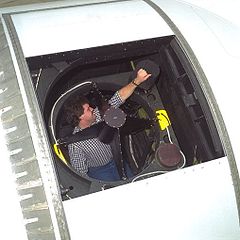Kuiper Airborne Observatory
| KAO | |
|---|---|
 |
|
| The KAO in flight. | |
| Other name(s) | Kuiper Airborne Observatory Gerard P. Kuiper Airborne Observatory |
| Type | Lockheed C-141A Starlifter |
| Manufacturer | NASA |
| Construction number | 6110 |
| Registration | N714NA |
| Serial | NASA 714 |
| Owners and operators | NASA |
| In service | 1974-1995 |
| Preserved at | Moffett Field |
| Role | Airborne observatory |
| Status | Retired |
| Developed from | Lockheed C-141 Starlifter |

The telescope for KAO
|
|
| Organization | NASA |
|---|---|
| Coordinates | 37°25′17″N 122°02′51″W / 37.4214649°N 122.047412°WCoordinates: 37°25′17″N 122°02′51″W / 37.4214649°N 122.047412°W |
|
[]
|
|
The Gerard P. Kuiper Airborne Observatory (KAO) was a national facility operated by NASA to support research in infrared astronomy. The observation platform was a highly modified Lockheed C-141A Starlifter jet transport aircraft (s/n: 6110, registration: N714NA, callsign: NASA 714) with a range of 6,000 nautical miles (11,000 km), capable of conducting research operations up to 48,000 feet (14 km).
The KAO was based at the Ames Research Center, NAS Moffett Field, in Sunnyvale, California. It began operation in 1974 as a replacement for an earlier aircraft, the Galileo Observatory, a converted Convair 990 (N711NA), that was destroyed in a collision with a U.S. Navy Lockheed P-3C Orion patrol aircraft in 1973.
The KAO's telescope was a conventional Cassegrain reflector with a 36-inch (91.5 cm) aperture, designed primarily for observations in the 1 to 500 μm spectral range. Its flight capability allowed it to rise above almost all of the water vapor in the Earth's atmosphere (allowing observations of infrared radiation, which is blocked before reaching ground-based facilities), as well as travel to almost any point on the Earth's surface for an observation.
The KAO made several major discoveries, including the first sightings of the rings of Uranus in 1977 and a definitive identification of an atmosphere on Pluto in 1988. The KAO was used to study the origin and distribution of water and organic molecules in regions of star formation, and in the vast spaces between the stars. Kuiper astronomers also studied the disks surrounding certain stars that may be related to the formation of planetary systems around these stars. It took infrared spectrum measurements of the planet Mercury in 1995. No quartz or olivine in Mercury's surface rocks was detected.
...
Wikipedia
